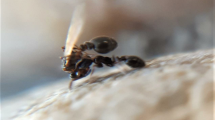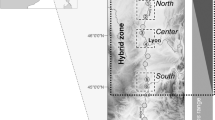A parasitic ant has abandoned the multiple mating habit of the queens of its related host.
Abstract
Multiple mating (polyandry) is widespread among animal groups, particularly insects1. But the factors that maintain it and underlie its evolution are hard to verify because benefits and costs are not easily quantified and they tend to be similar in related species. Here we compare the mating strategies of the leaf-cutting ant Acromyrmex echinatior and its recently derived social parasite Acromyrmex insinuator, which is also its closest relative2 (see Fig. 1). We find that although the host queens mate with up to a dozen different males, the social parasite mates only singly. This rapid and surprising reversion to single mating in a socially parasitic ant indicates that the costs of polyandry are probably specific to a free-living lifestyle.

D. R. NASH
Small worker ants cluster around the parasite queen.
This is a preview of subscription content, access via your institution
Access options
Subscribe to this journal
Receive 51 print issues and online access
$199.00 per year
only $3.90 per issue
Buy this article
- Purchase on Springer Link
- Instant access to full article PDF
Prices may be subject to local taxes which are calculated during checkout

Similar content being viewed by others
References
Simmons, L. W. Sperm Competition and its Evolutionary Consequences in the Insects (Princeton University Press, Princeton, 2001).
Sumner, S., Aanen, D. K., Delabie, J. & Boomsma, J. J. Insectes Soc. 51, 37–42 (2004).
Crozier, R. H. & Fjerdingstad, E. J. Ann. Zool. Fenn. 38, 267–285 (2001).
Villesen, P., Murakami, T., Schultz, T. R. & Boomsma, J. J. Proc. R. Soc. Lond. B 269, 1541–1548 (2002).
Sumner, S., Nash, D. R. & Boomsma, J. J. Proc. R. Soc. Lond. B 270, 1315–1322 (2003).
Sumner, S., Hughes, W. O. H. & Boomsma, J. J. Behav. Ecol. Sociobiol. 54, 256–263 (2003).
Bekkevold, D. & Boomsma, J. J. J. Evol. Biol. 13, 615–623 (2000).
Pedersen, J. S. & Boomsma, J. J. Mol. Ecol. 8, 577–587 (1999).
Ortius-Lechner, D., Gertsch, P. J. & Boomsma, J. J. Mol. Ecol. 9, 114–116 (2000).
Villesen, P., Gertsch, P. J. & Boomsma, J. J. Mol. Ecol. Notes 2, 320–322 (2002).
Chao, A. & Lee, S. M. J. Am. Stat. Assoc. 87, 210–217 (1992).
Author information
Authors and Affiliations
Corresponding author
Ethics declarations
Competing interests
The authors declare no competing financial interests.
Rights and permissions
About this article
Cite this article
Sumner, S., Hughes, W., Pedersen, J. et al. Ant parasite queens revert to mating singly. Nature 428, 35–36 (2004). https://doi.org/10.1038/428035a
Issue Date:
DOI: https://doi.org/10.1038/428035a
This article is cited by
-
A putatively new ant species from the Cataglyphis cursor group displays low levels of polyandry with standard sexual reproduction
Insectes Sociaux (2023)
-
Evolution of reproductive traits in Cataglyphis desert ants: mating frequency, queen number, and thelytoky
Behavioral Ecology and Sociobiology (2016)
-
The cost of promiscuity: sexual transmission of Nosema microsporidian parasites in polyandrous honey bees
Scientific Reports (2015)
-
Colony size is linked to paternity frequency and paternity skew in yellowjacket wasps and hornets
BMC Evolutionary Biology (2014)
-
Short independent lives and selection for maximal sperm survival make investment in immune defences unprofitable for leaf-cutting ant males
Behavioral Ecology and Sociobiology (2014)
Comments
By submitting a comment you agree to abide by our Terms and Community Guidelines. If you find something abusive or that does not comply with our terms or guidelines please flag it as inappropriate.



